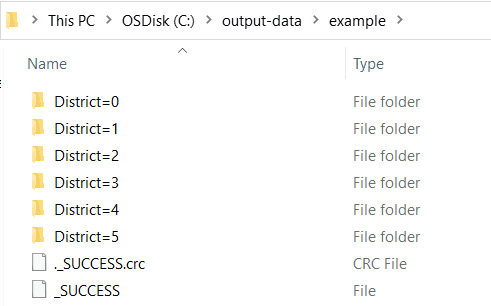Apache Parquet (.parquet) is an open-source type-aware columnar
data storage format that can store nested data in a flat columnar format. Parquet is commonly used in the Apache Spark
and Hadoop ecosystems as it is compatible with large data streaming and processing workflows. Parquet is highly
structured meaning it stores the schema and data type of each column with the data files.
To learn more about Parquet data format, see the Apache Parquet documentation.
To learn more about using Parquet files with Spark SQL, see Spark's documentation on the Parquet data source.
Parquet data can be stored in a distributed file system such as HDFS, cloud storage, a local directory, or any other location accessible to Spark.
After you load one or more Parquet files as a Spark DataFrame, you can create a geometry column and define its spatial reference using GeoAnalytics Engine SQL functions. For example, if you had polygons stored as WKT strings you could call ST_PointFromText to create a point column from a string column and set its spatial reference. For more information see Geometry.
After creating the geometry column and defining its spatial reference, you can perform spatial analysis and visualization using the SQL functions and tools available in GeoAnalytics Engine. You can also export a Spark DataFrame to Parquet files for data storage or export to other systems.
The following table shows several examples of how to load and save Parquet files in Spark, where path is a path to a
directory of Parquet files or a single Parquet file.
| Load | Save |
|---|---|
spark.read.parquet(path) | df.write.parquet(path) |
spark.read.format("parquet").load(path) | df.write.format("parquet").save(path) |
spark.read.load(path, format="parquet") | df.write.save(path, format="parquet") |
Additionally, Spark Data and Data classes provide optional parameters that you
can use when reading or writing Parquet files. For a full list of options, see DataFrameReader.parquet
and DataFrameWriter.parquet.
| DataFrameReader option | Example | Description |
|---|---|---|
recursive | .option("recursive | Recursively look though Parquet files under the given directory. |
merge | .option("merge | Merge the schemas of a collection of Parquet datasets in the input directory. |
path | .option("path | Read in files with the specified name pattern under the given file path. |
| DataFrameWriter option | Example | Description |
|---|---|---|
partition | .partition | Partition the output by the given column name. This example will partition the output Parquet files by values in the date column. |
overwrite | .mode("overwrite") | Overwrite existing data in the specified path. Other available options are append, error, and ignore. |
Usage notes
-
The Parquet data source supports loading or saving DataFrames containing one or more geometry columns. These columns may not be understood as geometry columns by other systems that use Parquet.
-
Spatial reference info will not be saved with geometry columns written to Parquet files. The spatial reference needs to be manually set on each geometry column when loading Parquet files.
-
You can use
.coalesce(1)on the DataFrame to return a new DataFrame that has exactly one partition. Be cautious to use.coalesce(1)on a large dataset. -
Spark will read Parquet files from multiple directories if the directory names start with
column=. For example, the following example directory contains Parquet data that is partitioned bydistrict. Spark can inferdistrictas a column name in the DataFrame by reading the subdirectory names starting withdistrict=.
-
When reading in a directory of Parquet data with subdirectories not following the naming convention of
column=, Spark won't read from the subdirectories in bulk. You will need to add the glob pattern at the end of the root path (i.e.,Cor:\data\example\* C).:\data\example\*\* -
Consider explicitly saving the spatial reference in the Parquet as a column or in the schema in the geometry column name. To read more on the best practices of working with spatial references in DataFrames, see the documentation on Coordinate Systems and Transformations.
-
Be careful when saving to one Parquet file using
.coalesce(1)with large data. Consider partitioning large data by a certain attribute column to read and filter subdirectories of data and to improve performance. -
The schema of a nested geometry field may load differently from Parquet files depending on the Spark version. For example, in Spark 3.4, the schema of a point geometry column in a nested column is loaded as
Structinstead ofField(point, Struct Type( Struct Field(x, Double Type,false), Struct Field(y, Double Type,false), Struct Field(z, Double Type,false), Struct Field(m, Double Type,false)) Structat Spark 3.3.Field(point, Point UD T( None),true))